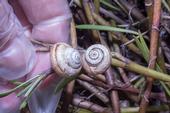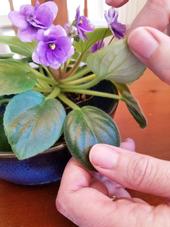- Author: Donald R. Hodel
- Posted by: Elaine Lander

Damage and...
- Author: Belinda J. Messenger-Sikes
- Author: Karey Windbiel-Rojas

Like outdoor plants, houseplants can also experience pest problems. Did you know that too much or too little watering is the most common way that houseplants die? They can also suffer from too much or too little light, incorrect fertilization, and a variety of pests and diseases. Knowing the proper growing conditions for your houseplant and checking regularly for signs of pests or disease are the best ways to keep your houseplants healthy.
If your houseplant is looking unhealthy, our newest publication Pest Notes: Houseplant Problems can help you find out what may be wrong. Authored by UCCE Environmental Horticulturalists Dennis...

Palm trees are commonly seen in California, making some think about the tree-lined streets of Hollywood, or sitting by the pool somewhere. These tropical or subtropical trees are beautiful and varied, with many different types of palms, each adapted for different growing conditions and each with specific disease-causing pathogens that can attack it.
Palm trees, like other plants, are susceptible to pathogens that can weaken or even kill the tree. Diseases such as diamond scale, pink rot, Fusarium wilt, and others can reduce the leaf canopy, discolor leaves and trunk, and cause distortion, stunting or death.
If you have palm trees or care for palms as part of your work, it's important to identify and know about these...
![Fig 1. Bronze bug adult. [G. Arakelian]](https://ucanr.edu/blogs/UCIPMurbanpests/blogfiles/44324small.jpg)
[From the May 2017 issue of the UC IPM Green Bulletin]
The bronze bug (Thaumastocoris peregrinus) (Fig. 1), a serious and potentially damaging, sap-sucking insect pest of eucalypts, has very recently been detected in southern California. This pest is reported to destroy extensive areas of leaf tissue, often giving it a bronze tint, turning it yellow, red, and then brown to tan. Damage from the bronze bug eventually leads to leaf loss, canopy thinning, branch die back, and even tree death. A wide host range and its ability to survive in a variety of...
![Fig 1. FLRP causes a distinctive,
tight, typically complete leaf roll. [D.R. Hodel]](https://ucanr.edu/blogs/UCIPMurbanpests/blogfiles/38888small.jpg)
[From the August 2016 issue of the UC IPM Green Bulletin]
A new psyllid pest that causes a distinctive, tight, typically complete rolling of leaves (Figure 1), has been found on Ficus microcarpa (Chinese banyan, Indian laurel fig) in Los Angeles, Orange, San Bernardino, Ventura, San Diego, and Riverside counties. This species of Ficus is one of our most common, useful, and widespread ornamental landscape trees. Incidentally, it has also long been a target for numerous exotic pests.
The psyllid, identified as Trioza...


